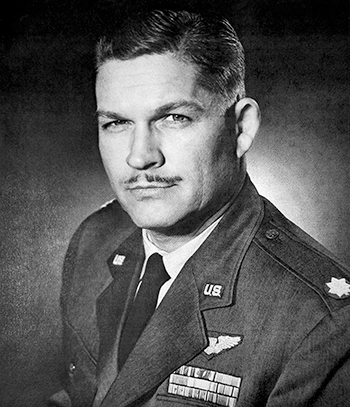
|
Kermit K. Beahan |
 |
|||
| Rank, Service | ||||
Lieutenant Colonel O-5, U.S. Air Force |
||||
| Veteran of: | ||||
|
||||
| Tribute: | ||||
Kermit Beahan was born on August 9, 1918, in Joplin, Missouri. He enlisted in the Aviation Cadet Program of the U.S. Army Air Corps for pilot training on July 30, 1940, but failed to complete flight training and was honorably discharged at Barksdale Field, Louisiana, on September 11, 1940. Beahan again enlisted in the Aviation Cadet Program, this time for Bombardier training, on June 1, 1941, and was commissioned a 2nd Lieutenant in the U.S. Army Air Forces and awarded his Bombardier wings at Barksdale Field on December 16, 1941. Lt Beahan attended B-17 Flying Fortress aircrew training at Albuquerque Army Air Field, New Mexico, from December 1941 to April 1942, and then served as a B-17 bombardier with the 358th Bomb Squadron of the 303rd Bomb Group at Gowen Field, Idaho, from April to May 1942; from Muroc Army Air Field, California, from May to June 1942; and from Alamogordo Army Air Field, New Mexico, from June to July 1942. His next assignment was as a B-17 bombardier with the 342nd Bomb Squadron of the 97th Bomb Group in England from July to November 1942, and then with the same squadron stationed in Algeria from November 1942 until he returned to the United States in February 1943. Lt Beahan served as a B-24 Liberator bombardier with the 502nd Bomb Squadron of the 346th Bomb Group at Dyersburg Army Air Field, Tennessee, from May to August 1943, and then as a bombardier at Galveston Army Air Field, Texas, from August to November 1943. His next assignment was as a B-17 instructor bombardier with the 395th Combat Crew Training School at Ardmore Army Air Field, Oklahoma, from November 1943 to April 1944, followed by served as a B-17 instructor bombardier with the 222nd Army Air Forces Base Unit at Ardmore Army Air Field from May to September 1944. Capt Beahan served as a B-29 Superfortress bombardier with the 216th Army Air Forces Base Unit at Wendover Army Air Field, Utah, from October 1944 to January 1945, and then as a B-29 bombardier with the 393rd Bomb Squadron of the 509th Composite Group at Wendover Field from January 1945 until he deployed with his squadron to the Pacific Theater in April 1945. His next assignment was as a B-29 bombardier with the 393rd Bomb Squadron at North Field, Tinian, from May to October 1945, and then at Roswell Army Air Field, New Mexico, from October 1945 to January 1946. During this time he was the bombardier aboard the B-29 "The Great Artiste" which served as the observation/instrument plane on the first atomic bombing mission against Hiroshima, Japan, on August 6, 1945, and he was the bombardier aboard the B-29 "Bockscar" which dropped the second atomic bomb on Nagasaki, Japan, on August 9, 1945. He turned 27 years old the day he flew on the mission to Nagasaki. Capt Beahan served as Group Bombardier for the 509th Composite Group at Roswell from January to August 1946, and during this time he participated in the Operation Crossroads atomic bomb tests at Bikini Atoll in June and July 1946. He returned to the 393rd Bomb Squadron at Roswell from August to October 1946, and then served a special assignment in Psychological Testing for Air Crew Training with the 3543rd Army Air Forces Base Unit at Kelly Army Air Field, Texas, from October to November 1946. His next assignment was as a B-29 bombardier with the 715th Bomb Squadron of the 509th Composite Group at Roswell from November 1946 to March 1948, followed by service as Staff Bombardier and Special Weapons Officer with the 509th Bomb Group at Roswell from March to November 1948. He served as Assistant Chief of the Training Section, Special Projects Officer, Chief of Special Weapons Branch Operations, and then Chief of the Special Weapons Section Operations Plans Branch with Headquarters 8th Air Force at Carswell AFB, Texas, from November 1948 to June 1952. Major Beahan next served as Weaponier with the Bomb Branch and then as an Operations Staff Officer with Headquarters 7th Air Division at RAF South Ruislip, England, from June 1952 to August 1956, followed by additional bombardier training with the 3535th Student Squadron at Mather AFB, California, from August 1956 to October 1957. Lt Col Beahan attended the Advanced Electronic Countermeasures Course at Keesler AFB, Mississippi, from October 1957 to May 1958, and then served as Chief of the Electronic Intelligence Branch with Headquarters Strategic Air Command at Offutt AFB, Nebraska, from May to August 1958. His next assignment was as Chief of the Electronic Intelligence Division and the Electronic Intelligence Center with the 544th Reconnaissance Technical Group (544th RTG) at Offutt AFB from September 1958 to August 1960, followed by service as Chief of the Defense Analysis Center with the 544th RTG at Offutt from August 1960 to March 1964. During this time the 544th RTG was redesignated the 544th Aerospace Reconnaissance Technical Wing (544th ARTW) on January 1, 1963. Lt Col Beahan served as Administrative Assistant to the Commander of the 544th ARTW at Offutt from March to May 1964, and then as Chief of the Electronic Collection Division with Headquarters U.S. Air Forces in Europe at Lindsey Air Station, West Germany, from May to December 1964. He was a patient at Wilford Hall U.S. Air Force Hospital at Lackland AFB, Texas, from December 1964 until he was medically retired from the Air Force on April 16, 1965. Kermit Beahan died on March 10, 1989, and was buried at the Houston National Cemetery in Houston, Texas. He remains to this day the last person ever to drop a nuclear weapon in combat. |
||||
|
||||

